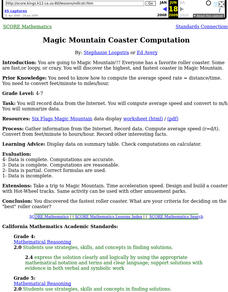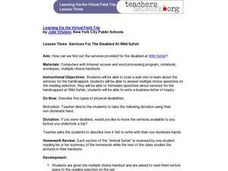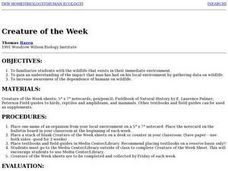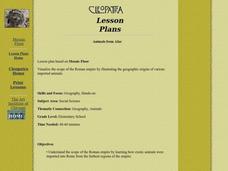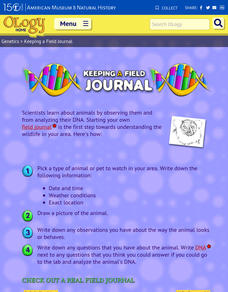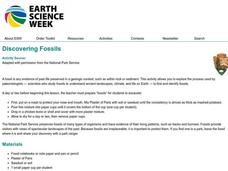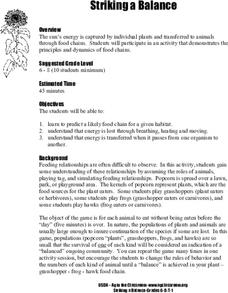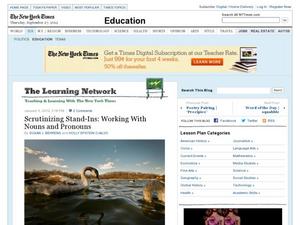Curated OER
Sights and Sounds with Spot
First graders view an animated picture on a Web site. Creatively they decide which objects to add to the picture for flair. In addition, sentences are written to describe what they see and hear in the picture they helped to create.
Curated OER
Sudan Surprise
Students consider animal migration patterns that have been recently documented in Sudan. They investigate the migratory patterns of animals and discuss how human conflicts and activities affect migratory wildlife populations.
Curated OER
Physics at the Zoo
Students visit a local zoo and answer physics questions that are a part of zoo life. In this zoo physics lesson students answer questions that have to do with the physics of animal size, their center of gravity and how animals travel.
Curated OER
Magic Mountain Coaster Computation
Students use the Internet to do research on the roller coasters at Magic Mountain Amusement Park. They must use mathematical formulas to calculate the highest and fastest coaster at the park.
Curated OER
Good Timing
Students examine sculptures which include animal figures made of different metals. They create their own sculptures of watches to represent a phrase about time.
Curated OER
Bison Sites of Texas
Learners locate bison-related sites on a map and identify important bison-related sites. The Bison has had a profound effect on the history of Texas and studenst discover the importance of the animal to the history of the state.
Curated OER
Services for the Disabled At Wild Safari
Students discover and enter the website for Six Flags Amusement park. Individually, they identify and discuss the types of services available to the handicapped. After reading the website, they answer comprehension questions and write...
Curated OER
Forests
Learners examine soil in forests looking for animals and insects. They divide the animals based on their number of legs and draw the animal they have collected.
Curated OER
Creature of the Week
Students explore the habits and biology of the wildlife that resides in their area. They fill in a Creature of the Week sheet for a different animal each week using field guides and textbooks.
Curated OER
Explorit's Picnic Time Quiz
In this outdoor picnic worksheet, students complete a six question multiple choice on-line interactive quiz about animal and insect encounters that are possible while on a picnic.
Curated OER
Animals from Afar
Students visualize the scope of the Roman empire by illustrating the geographic origins of various imported animals. They study how exotic animals were imported into Rome from the farthest regions of the empire.
Curated OER
Read-Alouds for the Holidays and Winter
These five titles will inspire creativity, research, and reflection in your classroom.
Curated OER
The Web of Life
Students demonstrate the interrelationships of animals and plants. In this ecology lesson, students discuss the things plants and animals need for survival and study the glacier food chain. Students simulate the web of life by using a...
American Museum of Natural History
Keeping a Field Journal
Recording scientific evidence allows for important discoveries and conclusions. A remote learning resource outlines how to create a field journal to record scientific observations. The outline resource includes notation about the...
American Museum of Natural History
Keeping a Field Journal
Young scientists begin a field journal by following four steps. A real-world example of an entry showcases the different parts, including location, date, drawings, and more.
Curated OER
Discovering Fossils
Students explore fossils. For this fossils geology lesson, students use tools to reveal embedded "fossils" (made with plaster of Paris by the teacher-instructions included), then describe and illustrate their findings.
Stanford University
Solstice and Equinox Season Model
How can December 21 be the shortest day of the year when all days are 24 hours long? Pupils see how to build a model showing the differences between winter and summer solstices and equinoxes. Using this model, classes can then discuss...
Curated OER
Visual Vocabulary
Students interpret and name the vocabulary termed acted out by the mime. In this science/language arts/physical education instructional activity, students are given a set of vocabulary terms to discuss within their group. Next, students...
National Park Service
Subalpine Web
The theory of keystone species in an ecosystem was first established in 1969 by Robert T. Paine. Pupils open the final lesson in a five-part series with a game guessing which member of the alpine ecosystem they are based on clues. After...
K5 Learning
Rhyming Animals
Second graders read an informational text passage on animals, as well as a poem that incorporates rhyming words. Then, 2nd graders answer questions based on what they read.
Curated OER
Forest Layers
Fourth graders observe the layers of the forest on a walk in the woods. They break up into groups to create murals, posters, or brochures illustrating the forest layers of Washington's Lowland Forests.
Curated OER
Striking a Balance
Students demonstrate understanding of food chain by assuming roles of animals, playing tag, and simulating feeding relationships.
Curated OER
Striking a Balance
Students explore the many different food chains. They participate in a game in which the class is divided into the different parts of the food chain.
Curated OER
Scrutinizing Stand-Ins: Working With Nouns and Pronouns
Use the Schoolhouse Rock episode, "Rufus Xavier Sarsaparilla," to introduce a study of pronouns. Learners consider antecedents, cases (nominative, objective and possessive), as well as types of pronouns, and then craft sentences using...



